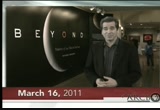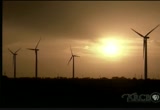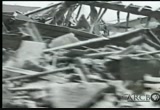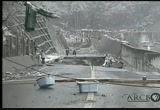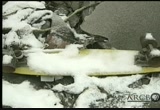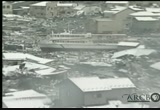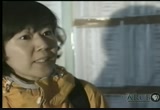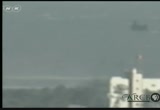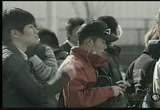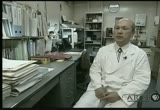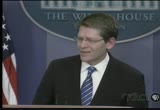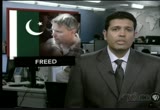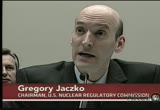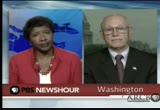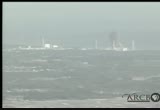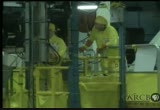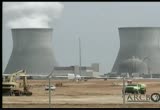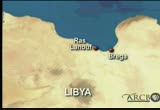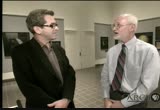tv PBS News Hour PBS March 16, 2011 5:30pm-6:30pm PDT
5:30 pm
captioning sponsored by macneil/lehrer productionsç ç >> woodruff: radiation levels spiked in the area around japan's damaged fukushima nuclear plant today, forcing emergency workers to temporarily abandon the facility, as tens of thousands of homeless struggled with snows and bitter cold. good evening, i'm judy woodruff. >> ifill: and i'm gwen ifill. on the "newshour" tonight, we get the latest on efforts to control the growing crisis in japan, including the stories of survivors and rescue crews in towns virtually wiped out by the tsunami. >> woodruff: we examine the health risks from the radiation spewing from the reactors and
5:31 pm
being carried by the wind far from japan's shores. >> ifill: plus, kwame holman looks at the u.s. nuclear energy industry in the context of japan's current crisis. >> woodruff: then, jeffrey browç updates the conflict in libya,ç as moammar qaddafi's forces move against key rebel strongholds. >> ifill: and science correspondent miles o'brien reports on nasa's next deep space ambitions, including a journey to the planet closest to the sun. >> we'll take you to mercury and beyond. you know, the solar system is not the same place you learned about in grade school. >> woodruff: that's all ahead on tonight's "newshour." major funding for the pbs newshour has been provided by: in 1968, as whaling continued worldwide, the first recordings of humpback songs were relqb:qb. ( whale singing ) public reaction mud to international bans. whale populations began to recover. at pacific life, the whale
5:32 pm
symbolizes what is possible if people stop and think about the future. help protect your future with pacific life-- the power to help you succeed. ♪ ♪çç moving our economy for 160 years. bnsf, the engine that connects us. >> and by the bill and melinda gates foundation. dedicated to the idea that all people deserve the chance to live a healthy productive life. ç
5:33 pm
and with the ongoing support of these institutions and foundations. and... this program was made possible by the corporation for public broadcasting. and by contributions to your pbs station from viewers like you. thank you. >> woodruff: japan's nuclear crisis deepened today, as radiation levels jumped at a badly damaged nuclear plant. and for millions who survived last week's earthquake and tsunami, winter storms addedç misery to nuclear fears and theç struggle for food, water and basic comforts. we have a series of reports from "independent television news," beginning with alex thomson, who traveled today to the town of kamaishi.
5:34 pm
>> reporter: army aid convoys heading east over the central mountains into the quake zone this morning. several japanese have asked me what have we done to deserve an historically powerful earthquake this vast tsunami damage and now the bliz archdiocese?" with officials here now saying more than 4ç,000 people areç confirmed , we've come to the east coast so-to-see how far search-and-rescue for bodies has gone in this vast area of damage. our driver, shin, just can't believe what he's seeing. he was last here on holiday several years ago. >> ( translated ): the tsunami reached up there. there's only five homes left up there. all the rest are destroyed. >> reporter: at the coast, we meet hiromi and his plea to the
5:35 pm
wider world, that of so many here "it's freezing, we need blankets but much moreç with."ç >> ( translated ): let's be frank, i need a bath and stuff like that. but i know it's too much to ask. it's so cold here. we need kerosene and we need petrol. >> reporter: we had seen towns wrecked, factories pulverized but never roads, bridges, and the vast anti-tsunami sea defenses here at kamaishi smashed like they were today. and hiromi had been good enough to explain to us exaly what happened here six days ago. it was about half an hour after the last of the earth tremors finished. people noticed that thisç entie bay began simplyç emptying with water. the tide went out way beyond the red hulk of the wrecked ship you can see there, out even beyond the lighthouse which you can just see sticking up in the
5:36 pm
snow. the entire bay was emptied of water and it stayed that way for some moments. then people living here describe an enormous rushing, roaring sound. it was the tsunami approaching 15, 20 miles an hour pushing everything before it. right up, right through this bay. the people living in the village in the corner there, many of them stayed put. they'd never had problems with on this occasion, things were very different. we decided to try and get there. clearly, no vehicles are going anywhere near. and look at the size of these supposed tsunami defenses. high enough, thick enough, long enough-- so everybody thought.ç
5:37 pm
an entire town stripped away to the elaborate foundations of houses designed to withstand earthquakes, yes, but a tsunami of this scale certainly not. we finally reached the part of the town where local people had fled, many stayed believing they'd be safe. family property and effects strewn around everywhere, demonstrating these people's faith in the vast ramparts of their sea walls was fatally misplaced. just look at it. there is no way you can gate vehicle anywhere near this vivillage. walking in is bad enough. it's pretty clear this village has not been reached. and i have to tell you, there is a fairly strong smell of decay coming from the buildings behind me, particularly that garage just there. one small example in one small
5:38 pm
village of the enormous job here in japan simply to locate the bodies let alone begin clearing up this mess. >> ifill: many japanese have been leaving the ravaged northeast coast, partly over radiation fears, and partly to find shelter. others are trying to help locate those who disappeared in friday's disaster. angus walker reports from the town of miyako, where the search continues. >> reporter: miyako, a fishing port where the harbor offered no sanctuary. aer if i have now marooned in the middle of town. you'd be forgiven for thinking this is a war zone. instead, it's a place where soldiers are battling to find victims of nature's forces. more than a thousand are missing it took the japanese army three days to get to miyako.
5:39 pm
they're still here, still searching for bodies. and the weather conditions are getting worse. this town can only be reached by mountainous roads. the sergeant tells me they've pulled ten people out alive since monday and if they only find one more, it will all still be worth it. this was the moment the tsunami smashed through miyako's defenses. a boat is slammed into a bridge. the waters had receded, exposing the destruction in their wake. now you get a real sense of the terrifying scale of this disaster. so much water poured over the sea wall that it hit the bottom of the bridge which must be around 30 feet above me. these are the lists of the living.
5:40 pm
more than 5,000 in emergency shelters. and this woman is one of japan's countless good samaritans. she has collected the names of the missing posted on the internet. she's come here hoping to find people she doesn't know on behalf of people she's never met. >> it is just horrible. it is a nightmare what's happened. i can't say anything. >> reporter: and all along japan's northeastern coast the nightmare never seems to end. >> woodruff: while the search went on for the living and the dead, the potential for a nuclear nightmare hung over japan for another day. a radiation surge sent levels to 300 times normal just south of the stricken fukushima plant. the levels dropped as the day went on. u.s. nuclear officials reported
5:41 pm
all the water has boiled away from a pool holding spent fuel rods-- a claim the japanese denied. but the plant owner said it's close to connecting a new power line to restore the plant's cooling system. sarah smith has more on the day's nuclear developments. >> reporter: helicopters carrying water to try to cool down an overheated nuclear reactor look like a pretty desperate last measure. it looks even worse when the choppers get turned back because there's too much radiation in the air already. you can see the smoke or steam that's pouring out of reactor number three. that's the most worrying development of the day. >> ( translated ): it burst out as smoke. it was very concentrated and when it was measured, it was highly radioactive. >> reporter: the power company now has to admit how dangerous the situation is, showing
5:42 pm
pictures of what two fires have done to reactor four. inside here, a small number of workers are left, putting themselves in danger trying to prevent a much greater catastrophe. even they had to evacuate for part of the day as radiation levels erupted. anxious citizens watched the news everywhere. they don't even know the names of the people still working inside fukushima, the human shields are japan's last defense against a full nuclear meltdown. then the emperor himself made very rare appearance on t.v. saying he's deeply concerned about the nuclear situation because it's so uncertain and he hopes with the help of those who remained at the plant things will not get worse. some people leaving the area around the nuclear plant are testing positive for radiation.
5:43 pm
this man fled from fukushima to tokyo. he told me and our translator he's worried he might have been can tamm nated but he can't get any hospital to test him. >> ( translated ): we can't see the radiation and even the tiniest amount could affect our health so no matter how far away i go, i don't feel safe. >> reporter: government instructions to evacuate the danger zone are repeated on the giant screen. people watching in tokyo find it hard to accept the official assurances that they are safe here. another thing that has people really worried is the feeling that they don't know f they can believe what their own government is telling them. normally, no country on earth has as much faith in its leaders and in its parliament as the japanese do. but now in the midst of this crisis, people are loudly complaining that the government is giving them contradictory information and that they're
5:44 pm
getting mixed messages about what's safe and what's not. and that's left everybody worried that the government's actually trying to hide the real truth. this eminent radiologist feels even he is being kept in the dark, and not just because of the continuing power cuts. think it is government is not telling people the whole truth. >> ( translated ): maybe the government isn't telling us everything because they are worried the country will panic. but people aren't stupid. if they were given a full explanation of what's happening, then they could make informed decisions. >> reporter: the french government thinks they have enough information to instruct all their nationals to leave tokyo. many multinationals are moving their staff out of the city while japanese residents are simply being told to keep calm and carry on. even in the face of an ongoing nuclear disaster that is worse than any other except chernobyl.
5:45 pm
>> woodruff: still to come on the "newshour": libyan forces loyal to qaddafi retake towns held by rebels and nasa goes to mercury. but first, with the other news of the day. here's hari sreenivasan. >> sreenivasan: the tokyo stock market rebounded today, but it wasn't enough to boost wall street. worries over japan's nuclear crisis sent the dow jones industrial average plunging 242 points to close at 11,613. the nasdaq fell 50 points to close at 2,616. the u.s. environmental protection agency has announced the first national limits on mercury pollution. the regulations laid out today are part of efforts to cut emissions from coal-fired power plants. advocates say the pollution contributes to birth defects and other problems. industry groups say the e.p.a. is inflating the benefits and under-stating the costs. power plants would have four years to comply, once the rules take effect. security forces in bahrain used tear gas and armored vehicles
5:46 pm
today to clear a central square in manama. at least five people were killed in the assault on protesters in pearl square. demonstrators' tents were also set on fire, sending plumes of smoke rising above the city. in washington, a okesman said president obama telephoned bahrain's leaders to deliver this message. >> there is no military solution to the problems in bahrain. there is no means of violence that will solve the unrest in the region, in any country, and that the future of those countries will be immeasurably brighter if the governments there engage in a political dialogue with the people. in yemen, government supporters attacked thousands of opposition demonstrators in sanaa with bullets, clubs, and daggers. hundreds of people were wounded. u.s. secretary of state hillary clinton visited the spawning ground for egypt's revolution today. clinton made an unscheduled stop in tahrir square in cairo,
5:47 pm
surrounded by heavy security and crowds. she greeted bystanders, and urged egypt's military rulers to carry out real democratic reforms. the secretary warned against letting anyone hijack the revolution. she promised the u.s. will help in any way it can. an american who says he killed two pakistani men in self- defense has been released from jail in pakistan. raymond davis had worked as a cia contractor. pakistani officials said he was let go after the victims' families received $2.3 million. secretary of state clinton denied washington made the payments. the u.s. insisted davis was covered by diplomatic immunity. those are some of the day's major stories. now, back to gwen. >> ifill: the nuclear scare went global today. as australia, germany, russia and other countries urged their citizens to leave tokyo and northern japan. the u.s. embassy recommended americans stay outside a 50-mile radius of the nuclear plant or take shelter indoors. by contrast, japanese officials have announced zones that extend
5:48 pm
to 20 miles for their civilians. u.s. troops were also told to stay 50 miles away and crews and equipment that flew over or near the nuclear plant were checked for signs of radiation. in washington, the head of the nuclear regulatory commission said emergency workers inside the plant are in grave danger. >> we believe that around the reactor site that there are high levels of radiation. it would be very difficult for emergency workers to get near to the reactors. the doses they could experience would potentially be lethal doses in a very short period of time. >> ifill: there's been much discussion about the radiation and health risks near the plant, the outlying areas and farther away. we try to make some sense of it now with lake barrett, a nuclear engineer and consultant who directed the clean-up of three mile island for the nuclear regulatory commission. and norman kleiman, a professor of environmental health sciences at columbia university's mailman school of public health in new york. his work focuses on exposure to radiation.
5:49 pm
blake, you have been involved in something similar to this for some time ago now. give us a sense of what's happening in that plant right now. >> well, the workers are coping with a very challenging, very difficult situation there at fukushima. they have three reactors cores that have been overheated and rubble and is probably partially melting in the cores. i believe those cores are stable at the moment with fire hoses and fire connections they have for the reactors. the most immediate concer is the two spent fuel pools in unit four and unit three. those apparently have overheated and there's been hydrogen released, explosions, some of the buildings have been damaged severely. and they're working very hard to try to contain that radioactivity as we speak. >> ifill: norman kleiman, we talk about the effects of radiation exposure.
5:50 pm
what distinction has the u.s. government drawn between saying there should be a 50 mile radius of safety for u.s. citizens and the japanese government is suggesting only a 20-mile radius. >> i think our government is being prudent and careful and conservative in its estimates about radiation exposure and not wanting to expose any individuals, any u.s. citizens to risk. i think it's a little difficult in the absence of concrete data and information for the u.s. government and the japanese government to actually know what the real risks are. they're just trying to be extra conservative and cautious in protecting the health of the populations. >> ifill: mr. kleiman, as they come up with these guidelines what's the distinction between advising people to stay indoors and advising people to get out all together? >> there are several ways to protect oneself's against ionizing radiation exposure. certainly shielding. so behind a barrier, the concrete, the wood, the brick of buildings affords some protection.
5:51 pm
distance affords some protection which is why the exclusion zone has been increased. and time. the dose rate and amount of time one is exposed to radiation. so ilt needs to be calculated and in the absence of knowing what the types of isotopes being released are, it's difficult to give hard data on what a safe level is. i think everyone is being very cautious and conservative. >> ifill: it is difficult to figure out but the thing most scientists seem to agree on is that this has now exceeded the danger that was at three mile island. is that your sense of it as well? >> yes, it is. >> ifill: so what do people do? what are the risks? how are they manifested for individuals who are either nearby or within the plant or even across the ocean? >> well, the people at the plant are trained nuclear professionals working very hard under very difficult conditions. radiation levels are high. it's... they have to wear protective suits and respirators. it's very difficult. but they are trained to understand the risks involved
5:52 pm
working with radioactive materials. the immediate people around the site, which is most affected, have been evacuated and you'll be reading reports of contamination and radiation levels and those will go up quite some distance from the plant but i believe if the people follow the directions of the government, i think from the health point of view i think they will be at very low risk. >> ifill: mr. kleiman, when we hear about risk and how the risk is manifested, do we know... is this an immediate risk? are the people who are there nearby immediately see signs of radiation poisoning or exposure or this something that only surfaces eventually? >> those workers in the plant themselves, if they're exposed to significant levels of radiation, will experience what's called acute radiation syndrome. these are at much higher levels than what's been reportedince so far, but symptoms such as nausea, gastrointestinal distress and a change in their bone marrow.
5:53 pm
these occur at doses of about 8.8 sieverts to one sievert. that's not been reported so far but we can presume that there are levels inside the plant, hopefully regions that the plant workers are not in right now, where those levels are present. for the general population, as distance increases, radiation exposure drops dramatically and based on the figures we've been given it's unlikely anyone would have any kind of symptoms from radiation exposure outside of the immediate vicinity of the plant. >> ifill: we are all exposed to some degree of radiation in our daily lives. how's the magnitude in this case different he? >> well, the earth is a radioactive place. it was radioactive before mankind was on this earth. so we are all exposed to natural radiation everyday. we're also exposed to man made radiation for medical exposures. in this plant are extremely high radiation levels that can be
5:54 pm
deadly if they're not properly managed. once you get away, yes, there will be increased risk due to increased radiation from the plant but i think the levels will be below those you would find in medical procedures. millions of people have medical procedures such as x-rays or diagnostic work done that involves radioactive materials and it's not a huge health risk. i would say this is not a health catastrophe but it's certainly an industrial catastrophe in the plant. >> ifill: so this run, mr. kleiman, we've been seeing on iodide pills, they're supposed to be some sort of... ameliorate whatever problem which crops. is that reasonable? >> probably not. iodide pills poe perot text against a unique kind of cancer that can be caused by radiation, thyroid cancer and they're only effective if they're taking immediately preceding a radiation exposure. certainly within the first 24 hours preceding an exposure. there's absolutely no evidence
5:55 pm
for anyone in the united states or hawaii or even in the area surrounding the plant that there have been increased levels of radioactive die dine that are of concern to the general population so while it may make people feel more comfortable, psychological benefit, the overall benefit is very low. >> ifill: there is some concern on the west coast that something in this cloud, something in this plume could, as the wind drives it across the pacific, it could end up here. >> that's virtually a zero risk type of situation. i don't think the people in caforn should be concerned one bit about it. >> ifill: and the people in tokyo? >> tokyo is quite a ways away and i don't think the people in tokyo should be worried, either, unless... if they follow the instructions they will get from their government as time goes on technical health risks are extremely low. i would consider it safe in tokyo. >> ifill: i do have to ask you this question because you were involved in the three mile
5:56 pm
island cleanup and there were a lot of things we didn't know about for years. is that going to be the case as well here? >> well, clearly what's going on this is the fog of war in an industrial accident. the people at the plant are dealing with. information flow is terrible to everybody. people are frustrated. they want to know what's going on but there's no way we can know when we're not in the plant itself and even those working in the plant is very difficult. so lessons learned on what happened and make things better and go forward and do a lot of cleanup but i don't believe this is a health catastrophe. >> ifill: lake barrett, norman kleiman, thank you for helping make sense of it all. >> woodruff: the nuclear crisis in japan is raising questions in the united states and elsewhere about whether to bank on more nuclear power for the future. in the u.s. alone, there are applications pending for 20 new reactors. "newshour" correspondent kwame holman reports. >> reporter: before last friday,
5:57 pm
nuclear power had been undergoing a rebirth of sorts-- a process that took decades following two catastrophes: the 1986 chernobyl disaster-- the worst accident ever-- and the 1979, 3-mile island partial meltdown in pennsylvania. but in recent years, nuclear has been heralded by the industry, many elected officials and some environmentalists as a clean and safe alternative to fossil fuels in a warming world. now, as technicians do battle at the crippled, 40-year-old fukushima dai-ichi reactors, prospects for developing nuclear energy worldwide are facing new questions. china said today it will suspend new plant approvals. and several european nations have powered down plants for safety checks, among them: germany. chancellor angela merkel yesterday: >> ( translated ): those nuclear plants which started running before the end othe year 1980 will be taken offline. >> reporter: there has been no talk of such a move from the
5:58 pm
obama administration. in the u.s., 104 nuclear power plants produce just less than 20% of the nation's total electricity load. but near those facilities, some residents worry about safety amid natural disasters. from san clemente, on california's coast: >> they're saying this ten-foot wall is going to hold a tsunami but i think differently. i think a tsunami is going to go right on over. >> reporter: to florida: >> i really feel like it could be catastrophic should we have natural disasters that are beyond our control. how we would contain this energy? >> holman: the topic of u.s. nuclear safety was one of many discussed by secretary of energy steven chu this morning during a house hearing on his department's budget. lawmakers searched for comparisons to the events unfolding across the pacific. >> the japan incidents actually appear to be more serious than three mile island. to what extent, we don't know now.
5:59 pm
>> reporr: chu said his department had dispatched teams to japan to monitor the crisis and assist the japanese. they also hope to apply lessons- learned here. >> what we want to do is look at what happened in japan and say, and look to whether we would be more vulnerable to a cascade of multiple events and how they might compromise safety. >> reporter: of particular interest to lawmakers, japan uses many reactors similar to those operating in the united states. a new power-generating u.s. reactor has not come online in 15 years and no new ground has been broken for a facility in more than twice that time. in september, president obama said nuclear must be part of an energy and climate strategy. >> if we're concerned about global warming and greenhouse gasses, nuclear energy is a legitimate fuel-- energy source that the japanese and the french have been using much more intelligently than we have. >> reporter: secretary chu reaffirmed the administration's
6:00 pm
commitment nuclear power today. as part of his budget, mr. obama proposed $36 billion in loan guarantees to help build as many as 20 new, nuclear plants. that follows on the 2005 energy bill signed by president bush, who sought to streamline the regulatory process and extend loan guarantees to the industry. the southern company has secured the sole loan guarantee under the 2005 program, to build two new reactors at a plant in georgia. construction is underway. >> ifill: now, to libya, where the opposition appears to be losing ground. jeffrey brown has that story. >> brown: thousands of people poured out of eastern libya today in a panicked rush into egypt to escape moammar qaddafi's troops.
6:01 pm
>> ( translated ): all qaddafi's forces are mercenaries and foreigners not libyans, and all libyans are united and they don't want qaddafi or anything related to him. >> brown: as they fled, another rebel stronghold was in danger of falling. the city of ajdabiyah was under assault by qaddafi's planes, tanks and troops and witnesses reported heavy damage. >> ( translated ): there is complete terror here now, everyone is frightened. >> brown: government forces had already seized ras lanouf and brega in their drive to re- conquer a region that fell into opposition hands early in the month-long uprising. the fall of ajdabiyah would open a gateway to benghazi, the major city in the east. protesters there put on a brave face today, at a rally against qaddafi's rule. at similar demonstrations this week, many insistethey would not surrender. >> we die for benghazi, even if he comes to inside benghazi here, it will be war. >> brown: closer to tripoli,
6:02 pm
the qaddafi's fighters also blasted rebels today in misrata, after retaking zawiyah in a bloody battle last week. meanwhile, the u.n. security council discussed imposing a no- fly zone on qaddafi's air force. but the libyan leader's son saif al-islam said it would do no good. >> ( translated ): military operations are over. within 48 hours, everything will be finished. our forces are almost in benghazi. whatever the decision, it will be too late. >> brown: meanwhile, secretary of state clinton in egypt today said she hopes for a u.n. vote on an international response no later than tomorrow. also today, the "new york times" reported four of its journalists are missing in libya. they disappeared tuesday while covering the rebels' retreat in the east. to update the overall situation we're joined again by dirk vandewalle. he's an associate professor of government at dartmouth college and author of "a history of modern libya." so how has qaddafi been able to
6:03 pm
seemingly turn things around and retake these towns? >> well, i think originally we had all anticipated that as the uprising proceeded that this would turn into a longer conflict which eventually this international community would have a chance to weigh in. but it now seems that the qaddafi has managed very skillfully to keep around him not only the revolutionary guards, he has also managed to keep bringing in mercenarys from subsaharan africa and overall he has simply managed also in part convincing the population in tripoli and certainly he has a number of supporters in tripoli that his political experiment is still viable and that what what he described as a fifth column, the united states and others coming in, may, indeed, be a danger to libya. so he's put all his resources, both military and ideological resources, into fighting off
6:04 pm
what he calls the invaders and, of course, that has primarily been done by the brigades headed by his two sons and that will perhaps prove instrumental if, indeed, the army now moves beyond ajdabiya toward benghazi. >> brown: speaking of benghazi just now on the wire, i don't know if you had a chance to see this, apparently the libyan army went on television tonight and issued an ultimatum to residents of the opposition... of benghazi warning them to leave rebel-held locations and weapons storage area. that sounds quite threatening. what is going on there? how strong is benghazi as an opposition capital right now? >> well, it is, indeed, a very ominous development, as you point out. the qaddafi government over the last few days has already distributed leaflets from helicopters in a number of cities in the east part of the
6:05 pm
country and saif al islam repeated that in his news conference earlier today saying the who oppose the regime, this is their last chance to get out and the way to get out is through egypt. what it means also, however is that we now have in benghazi the rep nathaniels of that uprising quite disorganized the leaders of the uprise having tried to come up with some kind of organization military organization, if at all possible but have simply proven unable to do so. so what we have in benghazi is really a ragtag army of irregulars. people who have really very little experience. there are very few experienced military men in benghazi so everybody is really worried because after and what in misurata, ajdabiya, it's clear this army by itself is not capable of withstanding what
6:06 pm
will undoubtedly be a pinscher movement if, indeed, the libyan army moves from ajdabiya along the coastal road and through a desert road into benghazi. >> brown: now in the meantime, as we watched and said in our set-up piece, there's been continued discussions and debate in the international community about a no-fly zone or other actions but nothing definitive. what is your read on that? which countries have been pushing hard? which countries have been most his tent? and where do things stand right now? >> i think the international community and particularly secretary clinton has realized-- and she indicated that in her comments today in cairo-- that in a sense a no-fly zone is no longer really sufficient because what we really face is now a final fight in benghazi that in part will only be fought with airplanes but mostly perhaps with armored units, with tanks and so on. and when secretary clinton was talking in cairo and she said
6:07 pm
that we would seek additional authorization from the international community for measures beyond the no-fly zone, in a sense she indicated that we needed to have these to really make any stands against the government forces possible so not just a no-fly zone but also sometimes what is called a no-drive zone. in other words, the ability to stop tanks and heavy artillery from moving toward benghazi. and, of course there has been an enormous amount of disagreement within the international community, the european i don't know union, the g-8 and then, of course, the security council at the united nations and it was not really until today really that a lot of... all of these support systems started to fall into place. and so when secretary clinton talked about the arab league as a sea change, she meant precisely that. that it now gives particular the united states, i think, the ability to move forward in
6:08 pm
cooperation with the united states... with the united nations security council and hopefully to do something before this final fight for benghazi really starts in earnest. >> brown: all right, we will leave it there. dirk vandewalle, thank you once again. >> woodruff: we'll be back shortly with miles o'brien's report on nasa's mission to mercury. this break allows your public television station to ask for your support. that support helpseep programs like ours on the air.
6:15 pm
>> woodruff: finally tonight, a journey long in the making as a nasa spacecraft nears the planet mercury's orbit, six years after it was launched. "newshour" science correspondent miles o'brien reports on how this mission fits into a major era of planetary exploration. >> reporter: i took a stroll through our solar system the other day. it is not the same place i learned about in grade school. >> the last several decades have just been an explosion of
6:16 pm
information about the solar system. >> reporter: my guide was planetary geologist jim zimbelman with the national air and space museum. the gallery is called "beyond," based on the book by michael benson. >> i mean, that to me is remarkable that we ha learned so much so quickly and its ongoing, that's the fun part. >> reporter: ongoing indeed! we may take it for granted, but planetary scientists don't. they are quick to remind us we are living in a golden age of astronomical discovery. >> it's fantastic. it's like being alive during the first exploration of north america. >> reporter: scientist sean solomon hopes to write the next chapter at the planet closest to the sun-- mercury. >> so were finishing our family notebook by going to mercury. mercury is going to tell us about how the smallest and in many ways the most extreme of the siblings of earth that was born and has evolved. >> reporter: solomon is the principal investigator for
6:17 pm
nasa's messenger spacecraft. the first spacecraft designed to enter the orbit mercury. if all goes well, it will see the planet as never before, measure its weak atmosphere and magnetic field. once volcanically active, mercury is the densest planet. a place where a day lasts two years. the temperature range is 1,100 degrees. designing a spacecraft to withstand this extreme environment has been a huge challenge. eric finnegan is messenger's chief engineer at the applied physics laboratory in maryland. the heat shield is made of several layers of ceramic fabric and mylar. it is thin, but amazingly protective. on the sunny side, temperatures will reach 650 degrees fahrenheit. on this side would be what? >> so that about a foot away because this now had a titanium frame, so about a foot away would be like room temperature like we are today. >> that's amazing. >> reporter: the sun is 11 times stronger at mercury than here on earth, so only one third of the solar panels are populated with power generating cells. the rest are mirrors. and the panels will be tilted
6:18 pm
away so they don't melt. if all goes well, messenger will orbit mercury for a year orbiting the planet more than 700 times. >> every time we go to a new planet, around the planetary system, we are surprised. we are surprised by the diversity of phenomenon and the richness of the process as there we've conducted. >> reporter: that certainly has been the case on mars. >> reporter: jim zimbelman and i were marveling at some images captured by the seemingly indestructible rovers spirit and opportunity now seven years into their 90-day missions. they were sent to the red planet to find proof it was once warm and wet and now we are knee deep in the data. ( cheers ) >> reporter: steve squyres is the principal investigator for the mars exploration rovers, which landed successfully on mars in 2004. seven years later, it seems the mars euphoria is sustained
6:19 pm
>> and now, we've occupied the planet. we got rovers, we got orbiters. we've been to the farthest reaches of the solar system, with voyager, were about to go on an orbit around mercury. we understand the solar system in a way that it would have just been unimaginable when i was young. we've come so far and i think >> reporter: nasa's next craft headed for mars is taking shape inside a clean room at the jet propulsion lab in california. the mars science laboratory called curiosity is as big as a mini cooper, nuclear powered and designed to hunt for another essential ingredient of life-- organic molecules ashwin vasavada is the deputy project scientist for curiosity. >> we have a six foot arm with a jackhammer or a drill on the end of it. we can place that arm and that drill onto a rock to generate powder, sift the powder into the >> reporter: curiosity is slated to land on mars-- actually be lowered in an unprecedented nail biting sky crane fashion in 2012. it is designed to travel 660
6:20 pm
feet per day for just under two years. >> what we need is rocks that we could put into the terrestrial laboratories but that we've selected. not that just fell from the sky but that we have chosen for the maximum potential of preserving evidence of ancient martian life. >> reporter: number two on this list-- a visit to this fascinating place. you can't help but wonder what it would be like to be standing on that icy surface, you know? welcome to jupiter's icy moon europa. >> and we have explored the polar areas on earth which is similar but this entire moon is coated with that ice. >> reporter: the galileo spacecraft to study jupiter flew by europa several times in the late '90s and captured these stunning images.
6:21 pm
scientists are all but certain there is a liquid ocean beneath the ice. in fact, they believe europa-- the size of our moon-- has three times the amount of water in our oceans. >> i think europa has probably the best chance for life in our solar system beyond earth. >> reporter: bob pappalardo is a senior scientist at the jet propulsion lab. he is leading efforts to design a mission to europa which would use radar to measure the thickness of the ice and maybe lay the groundwork for a mission to see is anything is living in a europa ocean some day. >> we're not talking fish; we're not talking macrofauna; we're talking probably single-cell organism, if there's life at all. >> reporter: so the europans are >> reporter: europa isn't the only icy moon in our solar system that has scientists intrigued. there saturn's moon enceledus. >> so the ice can't be tens of kilometers thick to have that kind of fracturing going on and preserved as clearly as it is. >> reporter: these are water
6:22 pm
geysers on enceledus-- the images captured by the cassini spacecraft in 2006. >> you have liquid water; you have some of the right ingredients for life. >> reporter: linda spilker is cassini's project scientist. >> we just don't have the instruments on cassini to be able to definitively answer that question, but whenever you have liquid water, there's always that possibility probably very remote that you might have life with that world. >> reporter: the hunt for life also means understanding more about the evolution of planets. a craft called "dawn" will arrive at the asteroid vesta in july. asteroids are like planets with arrested development and thus serve as a frozen time capsule of the very beginning of our solar system. and while messenger homes in on mercury, a craft called "new horizons" is aiming for an arrival at pluto in 2014. when "new horizons" launched, pluto was still considered a planet. ithas since been demoted, but like i said, the solar system sure looks different these days.
6:23 pm
ed weiler is nasa's chief scientist. >> i would predict in this century, humans will prove that life exists somewhere else in the universe. whether it's past, present, fossils, bugs whatever. >> reporter: but this gallery did not come cheap and just he trio of missions envisioned to bring back mars rocks would cost at least $10 billion. has the science outgrown the budget? >> maybe in a national sense. maybe it is a global mission now or it should be that the kinds of science that were talking about may require not just one nation but many nations deciding that this is the importance that sciences do. >> reporter: out here, i suppose we are earthlings first. maybe that is best way to search this limitless frontier for something that might very well be looking for us. >> ifill: again, the major developments of the day: japan's nuclear crisis deepened, as radiation levels jumped at a badly damaged nuclear plant. the japan situation helped send
6:24 pm
wall street tumbling again. the dow jones industrial arage lost 240 points. and government forces in libya blasted another town in the east in their drive toward the rebel capital in benghazi. and to hari sreenivasan for what's on the "newshour" online. hari? >> sreenivasan: on our science page, find more on why a new mission to mars tops the space exploration wish list. on japan, read a q&a on relief efforts and view a map of live seismic activity plus, "art beat" has a dispatch from the south by southwest festival. it's a profile of a hearing- impaired filmmaker who seeks to appeal to deaf and hearing audiences alike. all that and more is on our web site: newshour.pbs.org. judy? >> woodruff: and that's the "newshour" for tonight. on thursday, we'll update the situation at japan's damaged reactors. plus, take a look at ireland's debt crisis. i'm judy woodruff. major funding for the pbs newshour has been provided by:
6:25 pm
>> i mean, where would we be without small businesses? >> we need small businesses. >> they're the ones that help drive growth. >> like electricians, mechanics, carpenters. >> they strengthen our communities. >> every year, chevron spends billions with small businesses. that goes right to the heart of local communities, providing jobs, keeping people at work. they depend on us. >> the economy depends on them. >> and we depend on them. >> you can't manufacture pride, but pride builds great cars. and you'll find in the people at toyota, all across america.
6:26 pm
and the william and flora hewlett foundation, working to solve social and environmental problems at home and around the world. and with the ongoing support of these institutions and foundations. and... this ogram was made possible by the corporation for public broadcasting. and by contributions to your pbs station from viewers like you. thank you. captioning sponsored by macneil/lehrer productions captioned by media access group at wgbh access.wgbh.org u forget it. yourself, so don't fall.
6:27 pm
380 Views
IN COLLECTIONS
KRCB (PBS) Television Archive
Television Archive  Television Archive News Search Service
Television Archive News Search Service 
Uploaded by TV Archive on

 Live Music Archive
Live Music Archive Librivox Free Audio
Librivox Free Audio Metropolitan Museum
Metropolitan Museum Cleveland Museum of Art
Cleveland Museum of Art Internet Arcade
Internet Arcade Console Living Room
Console Living Room Books to Borrow
Books to Borrow Open Library
Open Library TV News
TV News Understanding 9/11
Understanding 9/11
